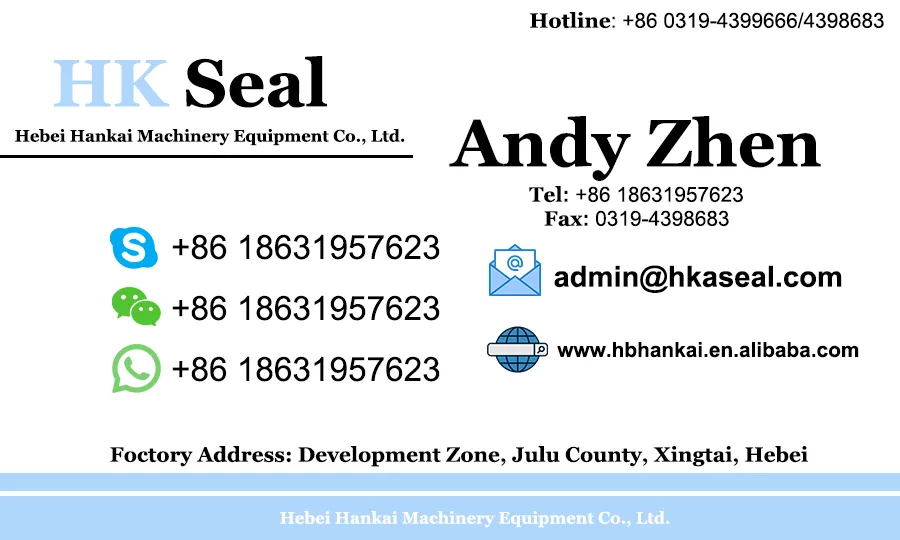Nov . 21, 2024 14:40 Back to list
hydraulic cylinder seal kit material
Understanding Hydraulic Cylinder Seal Kit Materials
Hydraulic cylinder seal kits play a crucial role in the functionality and longevity of hydraulic systems. These seals are essential in preventing fluid leakage and maintaining pressure within hydraulic cylinders, which are commonly used in various applications such as construction, manufacturing, and automotive industries. The effectiveness of a hydraulic cylinder seal kit largely depends on the materials used in its construction. In this article, we will explore the different types of materials used in hydraulic cylinder seal kits and their respective benefits.
Understanding Hydraulic Cylinder Seal Kit Materials
Another frequently used material is polyurethane (PU). PU seals offer superior abrasion resistance, making them ideal for applications where wear and tear are common. These seals also possess excellent resilience and flexibility, ensuring a tight fit within the hydraulic cylinder. Additionally, polyurethane can operate effectively in a temperature range of -30°C to 110°C and has good resistance to water and various hydraulic fluids. Its performance under dynamic conditions, such as those found in moving hydraulic components, is particularly notable.
hydraulic cylinder seal kit material

Fluorocarbon rubber, or Viton, is another high-performance material used in hydraulic seals. This material is known for its outstanding resistance to high temperatures, chemicals, and ozone. Viton seals can operate in environments ranging from -20°C to 200°C, making them suitable for more demanding applications. Because of their robust chemical resistance, fluorocarbon seals are often used in industries that handle aggressive fluids or require long-lasting seals, such as aerospace and chemical processing.
In recent years, advancements in material technology have also introduced thermoplastic elastomers (TPEs) into the realm of hydraulic seals. TPEs combine the properties of rubber and plastic, offering advantages such as lightweight, flexibility, and recyclability. These materials can be engineered for specific applications, providing tailored solutions for various hydraulic systems. The customizable nature of TPEs allows for enhanced performance in diverse operational conditions.
While the choice of material is critical, it is also essential to consider other factors such as the design of the seals, the compatibility with hydraulic fluids, and the working environment. Manufacturers often provide detailed recommendations regarding the optimal materials based on their specific hydraulic systems. It is important to follow these guidelines to ensure proper sealing and to optimize the performance and reliability of hydraulic equipment.
In conclusion, the selection of appropriate materials for hydraulic cylinder seal kits is vital for the efficient operation of hydraulic systems. From nitrile rubber and polyurethane to fluorocarbon rubber and thermoplastic elastomers, each material brings unique benefits tailored to different applications. Understanding these materials enables engineers and maintenance professionals to make informed decisions, ultimately leading to improved system performance and longevity. Proper maintenance and material selection will go a long way in ensuring the reliability and efficiency of hydraulic systems, reducing downtime and operational costs.
-
TCN Oil Seal Metal Ring Reinforcement for Heavy Machinery
NewsJul.25,2025
-
Rotary Lip Seal Spring-Loaded Design for High-Speed Applications
NewsJul.25,2025
-
Hydraulic Cylinder Seals Polyurethane Material for High-Impact Jobs
NewsJul.25,2025
-
High Pressure Oil Seal Polyurethane Coating Wear Resistance
NewsJul.25,2025
-
Dust Proof Seal Double Lip Design for Construction Equipment
NewsJul.25,2025
-
Hub Seal Polyurethane Wear Resistance in Agricultural Vehicles
NewsJul.25,2025
-
The Trans-formative Journey of Wheel Hub Oil Seals
NewsJun.06,2025
Products categories
















